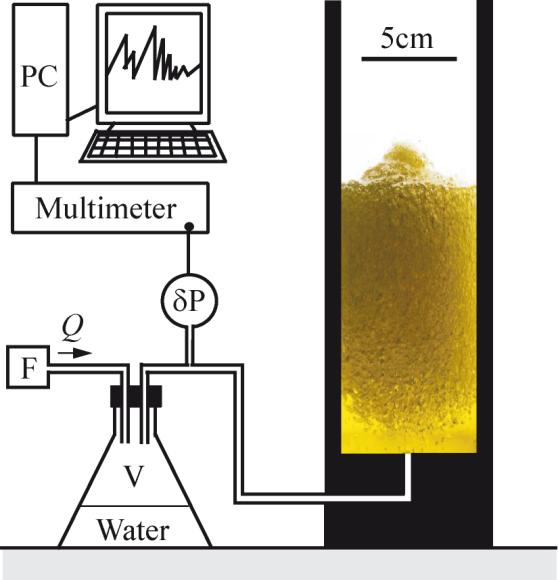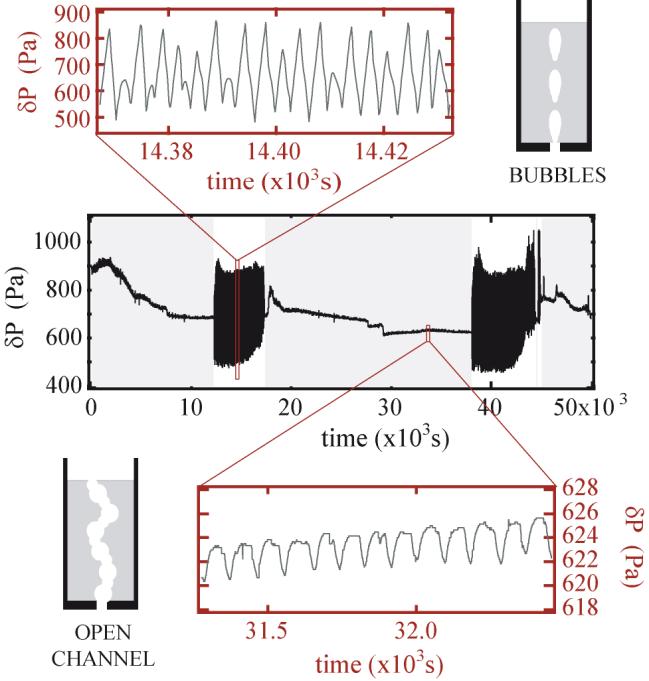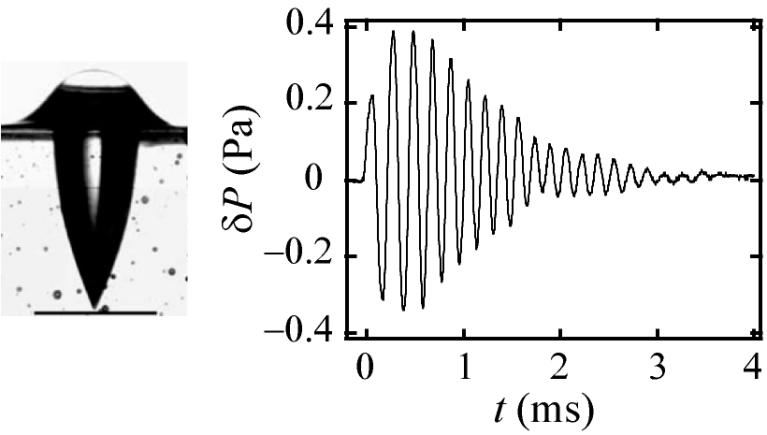Bubble acoustics and dynamics
T. Divoux, J.-C. Géminard, V. Vidal
Collaboration :
E. Bertin, F. Soubiran (LP-ENS, Lyon),
F. Melo (Universidad de Santiago, Chile),
M. Ripepe (Università degli Studi di Firenze, Italy),
D. Legrand (Universidad Autónoma de México, Mexico),
M. Ichihara (University of Tokyo, Japan)
Volcanoes are fascinating natural systems which present a wide range of dynamic behaviors, from puffing to lava fountains, or repetitive explosions of huge gas bubbles at the top of the magmatic conduit. Due to decompression, bubble nucleation and coalescence occur when the magma rises toward the surface. This dynamics is extremely complex, due to the non-Newtonian rheology of the magma (shear-thinning, yield strength fluid), the presence of strong temperature and pressure gradients, crystallisation, etc.
At the laboratory scale, we reproduce some of the physical processes involved in such natural systems. If the ultimate goal is the better understanding of volcano dynamics, the daily challenge is to quantify the fundamental aspects of degassing through a complex fluid. The main questions are the following: When injecting a gas through a non-Newtonian fluid column, what governs the changes of activity observed at the surface ? Which non-intrusive measurements provide accurate informations on the dynamics of the system ? How to link them with the fluid rheology – impossible to measure directly on the field ?
 Experimental setup
Experimental setup
Air is injected at constant flow-rate
at the bottom of a shear-thinning,
yield strength fluid (typically, gel).
By injecting a constant air flow at the base of a shear-thinning, yield-strength fluid column (typically, a gel), we evidenced different gas emission regimes: at low flow-rate, bubbles rise and burst independently one from the other (bubbling regime); at high flow-rate, an open channel connects the bottom air nozzle to the fluid free surface (channeling regime); finally, at intermediate flow-rate, we observe a spontaneous alternation between the two previous regimes (intermittent regime) [1,2]. The transition between the bubbling and the channeling regime is sharp, and directly linked to the fluid rheology [2]. The intermittent regime presents interesting statistical properties. In particular, for a given set of parameters (column height, fluid rheology, air flow-rate) the lifespan of the bubbling and channeling regimes do not exhibit the same distribution: while the bubbling regime has a characteristic life-time, the channeling regime does not [2]. This simple experiment shows that the non-Newtonian properties of the fluid can be responsible, alone, for a change of activity observed at the surface [3].
 Intermittent behavior of the overpressure
Intermittent behavior of the overpressure
measured at the bottom of the fluid column,
representative of the two regimes
(bubbling or channeling).
Non-intrusive measurements were performed by recording the acoustic signal emitted by the bubbles bursting at the surface. To fully characterize the origin of both the amplitude and frequency content of the acoustic signal at bursting, we have setup a model experiment consisting of a cylindrical cavity, closed by a thin soap film [4]. After injecting a given amount of air in the tube (fixed overpressure), the film bulges, then slowly drains before it ruptures. The analysis of the acoustic signal generated inside and outside the cavity pointed out that the bubble body (here, the cylindrical cavity) acts as a resonator at bursting. The frequency content is fixed by the tube geometry. The amplitude, however, strongly varies from one experiment to the other, even for a constant initial overpressure. It depends on the film rupture time, i.e. on the film thickness at bursting. This last parameter, uncontrolled both in these experiments and on the field, makes it impossible to directly link the amplitude of the acoustic signal and the overpressure inside the bubble at bursting, which can have strong implications on field data analysis [5]. Based on this characterization, we analyzed the acoustic signal generated by the bursting of a single bubble of fixed volume at the free surface of a shear-thinning, yield-strength fluid [6]. Due to the fluid non-Newtonian properties, bubbles are elongated, and act as a resonator at bursting. The previous description therefore applies, and we can link the more complex bubble shape to the acoustic signal frequency content. In this experiment, the bubbles can be divided into two categories: small bubbles remain trapped at the surface by capillary forces, and the acoustic amplitude at bursting is very low, while large bubbles rise quickly and burst immediately, producing a higher-amplitude acoustic signal. Finally, when considering the signal generated by successive bubbles bursting at the fluid free surface, we report a modulation of the acoustic signal spectral content [7]. This modulation is directly linked with the fluid rheological properties. We report the existence of a precursor signal, previous to each bursting. In addition with the previous results, this last point shows that laboratory experiments, although simple, bring real challenges in the prediction and mitigation of natural disasters.
These studies have been lately complemented by the analysis of the degassing process through a thin layer of viscoelastic fluid. When the layer in thin, one observes that the gas crosses the layer in periodic series of bubbles (cascades) [8].
 Bubble in a hair-gel solution and associated acoustic signal at bursting.
Bubble in a hair-gel solution and associated acoustic signal at bursting.
Note the elongated shape, with a cusp at the tail (black line = 1cm).
[1] T. Divoux, V. Vidal, F. Melo & J.-C. Géminard,
Dégazage intermittent à travers une colonne de fluide complexe,
Compte-rendus de la 11e Rencontre du Non-Linéaire, Eds. M. Lefranc, C. Letellier & L. Pastur, Non-Linéaire Publications, 31-36 (2008).
[2] T. Divoux, E. Bertin, V. Vidal & J.-C. Géminard,
Intermittent outgassing through a non-Newtonian fluid,
Phys. Rev. E 79, 056204 (2009).
[3] T. Divoux, V. Vidal, M. Ripepe & J.-C. Géminard,
Influence of non-Newtonian rheology on magma degassing,
Geophys. Res. Lett. 38, L12301(2011).
[4] V. Vidal, J.-C. Géminard, T. Divoux & F. Melo,
Acoustic signal associated with the bursting of a soap film which initially closes an overpressurized cavity. Experiment and theory,
Eur. Phys. J. B 54, 321-339 (2006).
[5] V. Vidal, M. Ripepe, T. Divoux, D. Legrand, J.-C. Géminard & F. Melo,
Dynamics of soap film bursting and its implications to volcano acoustics,
Geophys. Res. Lett. 37, L07302 (2010).
[6] T. Divoux, V. Vidal, F. Melo & J.-C. Géminard,
Acoustic emission associated with the bursting of a gas bubble at the free surface of a non-Newtonian fluid,
Phys. Rev. E 77, 056310 (2008).
[7] V. Vidal, M. Ichihara, M. Ripepe & K. Kurita,
Acoustic waveform of continuous bubbling in a non-Newtonian fluid,
Phys. Rev. E 80, 066314 (2009).
[8] V. Vidal, F. Soubiran, T. Divoux and J.-C. Géminard,
Degassing cascades in a shear-thinning viscoelastic fluid,
Phys. Rev. E 84, 066302 (2011)



